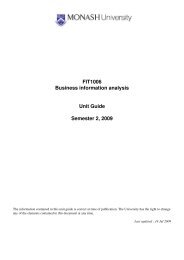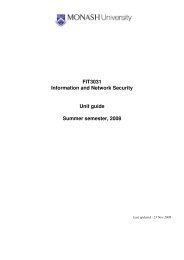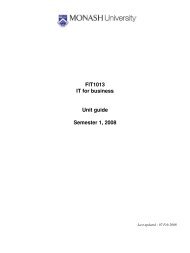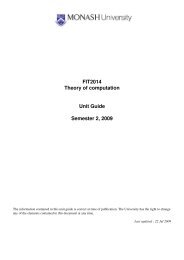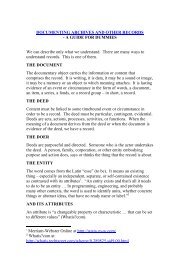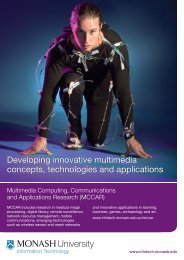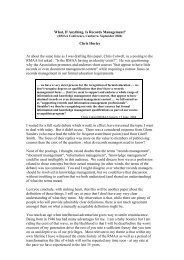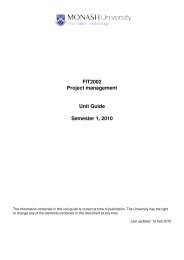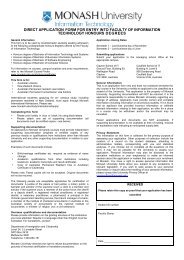FIT3003 Business intelligence and data warehousing Unit Guide ...
FIT3003 Business intelligence and data warehousing Unit Guide ...
FIT3003 Business intelligence and data warehousing Unit Guide ...
Create successful ePaper yourself
Turn your PDF publications into a flip-book with our unique Google optimized e-Paper software.
<strong>FIT3003</strong><strong>Business</strong> <strong>intelligence</strong> <strong>and</strong> <strong>data</strong> <strong>warehousing</strong><strong>Unit</strong> <strong>Guide</strong>Semester 2, 2009The information contained in this unit guide is correct at time of publication. The University has the right to changeany of the elements contained in this document at any time.Last updated : 15 Jul 2009
Table of Contents<strong>FIT3003</strong> <strong>Business</strong> <strong>intelligence</strong> <strong>and</strong> <strong>data</strong> <strong>warehousing</strong> - Semester 2, 2009..............................................................1Chief Examiner:................................................................................................................................................1Lecturer(s) / Leader(s):.....................................................................................................................................1Clayton................................................................................................................................................1Additional communication information:.......................................................................................................................1Introduction....................................................................................................................................................................2<strong>Unit</strong> synopsis.................................................................................................................................................................2Learning outcomes.........................................................................................................................................................2Contact hours.................................................................................................................................................................3Workload.......................................................................................................................................................................3<strong>Unit</strong> relationships...........................................................................................................................................................3Prerequisites......................................................................................................................................................3Relationships....................................................................................................................................................3Teaching <strong>and</strong> learning method.......................................................................................................................................4Timetable information......................................................................................................................................4Tutorial allocation.............................................................................................................................................4<strong>Unit</strong> Schedule...................................................................................................................................................4<strong>Unit</strong> Resources...............................................................................................................................................................5Prescribed text(s) <strong>and</strong> readings.........................................................................................................................5Recommended text(s) <strong>and</strong> readings..................................................................................................................5Required software <strong>and</strong>/or hardware..................................................................................................................5Equipment <strong>and</strong> consumables required or provided..........................................................................................5Study resources.................................................................................................................................................5Assessment....................................................................................................................................................................6Overview..........................................................................................................................................................6Faculty assessment policy................................................................................................................................6Assignment tasks..............................................................................................................................................6Examination......................................................................................................................................................7Due dates <strong>and</strong> extensions..................................................................................................................................7Late assignment................................................................................................................................................7Return dates......................................................................................................................................................7Appendix........................................................................................................................................................................8
<strong>FIT3003</strong> <strong>Business</strong> <strong>intelligence</strong> <strong>and</strong> <strong>data</strong> <strong>warehousing</strong> - Semester2, 2009Chief Examiner:Dr Damminda AlahakoonSenior LecturerPhone: +61 3 990 59662Fax: +61 3 990 58731Lecturer(s) / Leader(s):ClaytonDr Damminda AlahakoonSenior LecturerPhone: +61 3 990 59662Fax: +61 3 990 58731Additional communication information:Dr. Damminda AlahakoonClayton School of Information TechnologyFaculty of Information TechnologyMonash University, Clayton Vic 3800Phone + 61 3 9905 9662 Fax + 61 3 9905 5109Office : Room 132A, Bldg 631
<strong>FIT3003</strong> <strong>Business</strong> <strong>intelligence</strong> <strong>and</strong> <strong>data</strong> <strong>warehousing</strong> - Semester 2, 2009IntroductionWelcome to <strong>FIT3003</strong> <strong>Business</strong> Intelligence <strong>and</strong> Data Warehousing for semester 2, 2009. This is 6 point core unit inthe Bachelor of <strong>Business</strong> Information Systems degree.<strong>Unit</strong> synopsisThis unit provides students with an underst<strong>and</strong>ing of <strong>Business</strong> Intelligence (BI) systems <strong>and</strong> the infrastructureneeded to support them. Over the past decade OLAP tools, <strong>data</strong> mining <strong>and</strong> other <strong>data</strong> analysis techniques havebeen used to obtain value from <strong>data</strong> in ways not possible with earlier tools. Topics covered include the nature <strong>and</strong>purpose of BI, the relationship between BI <strong>and</strong> <strong>data</strong> <strong>warehousing</strong>, design issues related to BI tools <strong>and</strong> <strong>data</strong>warehouses, <strong>and</strong> common <strong>data</strong> analysis techniques such as OLAP, <strong>data</strong> mining <strong>and</strong> other computational techniques.The differences between these kinds of systems <strong>and</strong> other, more traditional information systems will be highlighted.Learning outcomesTo acquire the Knowledge <strong>and</strong> Underst<strong>and</strong>ing of:1. Role of Data Warehousing (DW) as oposed to operational <strong>data</strong>bases;2. The definition <strong>and</strong> the need of <strong>Business</strong> Intelligence (BI);3. DW development methodology;4. Dimensional models compared to ER models;5. BUS architecture;6. DW architectures, ETL <strong>and</strong> <strong>data</strong> quality issues;7. How DW can support BI;8. BI tools, techniques <strong>and</strong> OLAP;9. Data Mining (DM) techniques;10. Data Mining Tools.To develop the following Attitudes, Values <strong>and</strong> Beliefs:1. Recognise the value of DW <strong>and</strong> BI for a business organisation;2. Adapt a critical approach to DW <strong>and</strong> BI technology in a business context;3. Appreciate the value of DW for effective management support <strong>and</strong> decision making;4. Underst<strong>and</strong> the importance <strong>and</strong> value of BI tool <strong>and</strong> techniques compared to traditional <strong>data</strong> analysistechniques;5. Appreciate the value BI tools <strong>and</strong> DM for providing knowledge for decision making, in ways unavailablewith traditional techniques.To develop the following Practical Skills:1. Create dimensional models;2. Create DW architectures suitable for different organisations <strong>and</strong> requirements;3. Interpret results from OLAP <strong>and</strong> dimensional models;4. Create <strong>data</strong> analysis models using BI tools;5. Interpret results from BI <strong>and</strong> DM tools.In addition, it is expected that the following Relationships, Communication <strong>and</strong> Team Work skills will bedeveloped <strong>and</strong> enhanced:2
<strong>FIT3003</strong> <strong>Business</strong> <strong>intelligence</strong> <strong>and</strong> <strong>data</strong> <strong>warehousing</strong> - Semester 2, 20091. Document <strong>and</strong> communicate DW architectures <strong>and</strong> BI techniques;2. Work in a team during DW architecture design <strong>and</strong> BI model development;3. Communicate <strong>and</strong> coordinate during the team activities.Contact hours4 x contact hrs/weekWorkloadWorkload commitments are:* two-hour lecture <strong>and</strong>* two-hour tutorial (or laboratory) (requiring advance preparation)* a minimum of 2-3 hours of personal study per one hour of contact time in order to satisfy the reading <strong>and</strong>assignment expectations.You will need to allocate up to 5 hours per week in some weeks, for use of a computer, including time fornewsgroups/discussion groups.<strong>Unit</strong> relationshipsPrerequisitesOne of FIT1004, FIT2010, FIT1013 (BUS1010), BUS3112, CSE2316/3316Relationships<strong>FIT3003</strong> is a core unit in the Bachelor of <strong>Business</strong> Information Systems.3
<strong>FIT3003</strong> <strong>Business</strong> <strong>intelligence</strong> <strong>and</strong> <strong>data</strong> <strong>warehousing</strong> - Semester 2, 2009Teaching <strong>and</strong> learning methodThe unit will be delivered via lectures <strong>and</strong> laboratories.Lecture: During the lecture, your lecturer will introduce key theoretical concepts <strong>and</strong> demonstrate variousapproaches to <strong>data</strong>base tasks. The time in lectures is quite brief, please ensure you gain the best advantage from thistime by:Prior to the lecture:- reading the study guide for the appropriate week, <strong>and</strong>- downloading <strong>and</strong> reading the lecture notes,During the lecture ensuring that you:- annotate a printed set of lecture notes as the lecture proceeds, <strong>and</strong>- participate, question, seek clarificationAfter the lecture:- read over you notes <strong>and</strong> make sure you underst<strong>and</strong> the concepts- seek help if you are unsureTimetable informationFor information on timetabling for on-campus classes please refer to MUTTS, http://mutts.monash.edu.au/MUTTS/Tutorial allocationOn-campus students should register for tutorials/laboratories using the Allocate+ system:http://allocate.cc.monash.edu.au/<strong>Unit</strong> ScheduleWeek Topic Key dates1 Introduction to Data Warehousing2 Inroduction to Data Warehousing with SQL Server 20053 Data Warehouse Modeling4 Extract - Transform - Load5 Populating a Data warehouse <strong>and</strong> Reporting6 OLAP7 Data Mining with Statistics8 Decision Trees Assignment 1 due.9 Neural Networks <strong>and</strong> Data Mining10 Collaborative Filtering11 User ProfilingMid semester break12 CRM <strong>and</strong> Customer Management Assignment 2 due.13 Revision4
••••••<strong>FIT3003</strong> <strong>Business</strong> <strong>intelligence</strong> <strong>and</strong> <strong>data</strong> <strong>warehousing</strong> - Semester 2, 2009<strong>Unit</strong> ResourcesPrescribed text(s) <strong>and</strong> readingsBerry M, Linoff M. "Data Mining Techniques", John Wiley & Sons, 2004Text books are available from the Monash University Book Shops. Availability from other suppliers cannot beassured. The Bookshop orders texts in specifically for this unit. You are advised to purchase your text book early.Recommended text(s) <strong>and</strong> readingsKimball R, "Data <strong>warehousing</strong> toolkit" 2nd Edition, John Wiley & Sons, 2002Inmon W. H. "Building the Data warehouse" 2nd Edition, John Wiley & Sons, 2002Vitt E, Luckevich M, Misner S, "<strong>Business</strong> <strong>intelligence</strong>", 2002Required software <strong>and</strong>/or hardwareMicrosoft SQL Server 2008 with BI ToolkitTanagra <strong>data</strong> mining softwareEquipment <strong>and</strong> consumables required or providedStudents studying off-campus are required to have the minimum system configuration specified by the Faculty as acondition of accepting admission, <strong>and</strong> regular Internet access. On-campus students, <strong>and</strong> those studying at supportedstudy locations may use the facilities available in the computing labs. Information about computer use for studentsis available from the ITS Student Resource <strong>Guide</strong> in the Monash University H<strong>and</strong>book. You will need to allocateup to n hours per week for use of a computer, including time for newsgroups/discussion groups.Study resourcesStudy resources we will provide for your study are:Study resources we will provide for your study are:* Weekly detailed lecture notes outlining the learning objectives, discussion of the content, required readings <strong>and</strong>exercises;* Weekly tutorial or laboratory tasks <strong>and</strong> exercises with sample solutions provided one to two weeks later;* Assignment specifications <strong>and</strong> sample solutions;* A sample examination <strong>and</strong> suggested solution* This <strong>Unit</strong> <strong>Guide</strong> outlining the administrative information for the unit;* The unit web site on MUSO, where resources outlined above will be made available.5
•••••••<strong>FIT3003</strong> <strong>Business</strong> <strong>intelligence</strong> <strong>and</strong> <strong>data</strong> <strong>warehousing</strong> - Semester 2, 2009AssessmentOverviewExamination: 60%Assignments, class tests <strong>and</strong> laboratory exercises: 40%Students must pass the examination in order to pass the unit.Faculty assessment policyTo pass a unit which includes an examination as part of the assessment a student must obtain:40% or more in the unit's examination, <strong>and</strong>40% or more in the unit's total non-examination assessment, <strong>and</strong>an overall unit mark of 50% or more.If a student does not achieve 40% or more in the unit examination or the unit non-examination total assessment, <strong>and</strong>the total mark for the unit is greater than 44% then a mark of no greater than 44-N will be recorded for the unit.To pass this unit, a student must obtain :40% or more in the unit's examination <strong>and</strong>40% or more in the unit's non-examination assessment <strong>and</strong>an overall unit mark of 50% or moreIf a student does not achieve 40% or more in the unit examination or the unit non-examination assessment then amark of no greater than 44-N will be recorded for the unit.Assignment tasksAssignment coversheetsAssignment coversheets are available via "Student Forms" on the Faculty website:http://www.infotech.monash.edu.au/resources/student/forms/You MUST submit a completed coversheet with all assignments, ensuring that the plagiarism declaration section issigned.Assignment submission <strong>and</strong> return procedures, <strong>and</strong> assessment criteria will be specified with eachassignment.Assignment task 1Title:Assignment 1 - SQL Server <strong>and</strong> Data WarehousingDescription:Weighting:20%Due date:Week 86
••<strong>FIT3003</strong> <strong>Business</strong> <strong>intelligence</strong> <strong>and</strong> <strong>data</strong> <strong>warehousing</strong> - Semester 2, 2009Assignment task 2Title:Assignment 2 - Data MiningDescription:Weighting:20%Due date:Week 12ExaminationWeighting: 60%Length: 2 hoursType (open/closed book): Closed bookSee Appendix for End of semester special consideration / deferred exams process.Due dates <strong>and</strong> extensionsPlease make every effort to submit work by the due dates. It is your responsibility to structure your study programaround assignment deadlines, family, work <strong>and</strong> other commitments. Factors such as normal work pressures,vacations, etc. are not regarded as appropriate reasons for granting extensions. Students are advised to NOT assumethat granting of an extension is a matter of course.Students requesting an extension for any assessment during semester (eg. Assignments, tests or presentations) arerequired to submit a Special Consideration application form (in-semester exam/assessment task), along withoriginal copies of supporting documentation, directly to their lecturer within two working days before theassessment submission deadline. Lecturers will provide specific outcomes directly to students via email within 2working days. The lecturer reserves the right to refuse late applications.A copy of the email or other written communication of an extension must be attached to the assignmentsubmission.Refer to the Faculty Special consideration webpage or further details <strong>and</strong> to access application forms:http://www.infotech.monash.edu.au/resources/student/equity/special-consideration.htmlLate assignmentAssignments received after the due date will be subject to a penalty of 5% per day, including weekends.Assignments received later than one week (seven days) after the due date will not normally be accepted. In somecases, this period may be shorter if there is a need to release sample solutions.This policy is strict because comments or guidance will be given on assignments as they are returned, <strong>and</strong> samplesolutions may also be published <strong>and</strong> distributed, after assignment marking or with the returned assignment.Return datesStudents can expect assignments to be returned within two weeks of the submission date or after receipt, whicheveris later.7
••••••••••<strong>FIT3003</strong> <strong>Business</strong> <strong>intelligence</strong> <strong>and</strong> <strong>data</strong> <strong>warehousing</strong> - Semester 2, 2009AppendixPlease visit the following URL: http://www.infotech.monash.edu.au/units/appendix.html for further informationabout:Continuous improvement<strong>Unit</strong> evaluationsCommunication, participation <strong>and</strong> feedbackLibrary accessMonash University Studies Online (MUSO)Plagiarism, cheating <strong>and</strong> collusionRegister of counselling about plagiarismNon-discriminatory languageStudents with disabilityEnd of semester special consideration / deferred exams8



